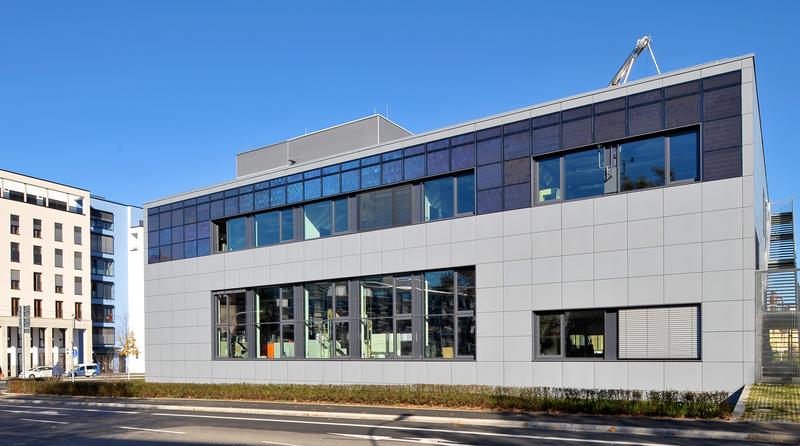
Innovative Photovoltaics – from the Lab to the Façade

The Fraunhofer Institute for Solar Energy Systems ISE has integrated 70 PV modules of its own development and production into the building façade of one of its laboratories.
©Fraunhofer ISE
The Fraunhofer Institute for Solar Energy Systems ISE has installed 70 photovoltaic modules on the outer façade of one of its lab buildings. The modules were developed and produced by the Institute and demonstrate the interplay of different technologies.
Together with industry, Fraunhofer ISE developed a crystalline PV module called “TPedge” using a process that saves both time and money and replaces the lamination step. Innovative back-contacted solar cells from the Institute’s own production are integrated into the module.
When the energy-efficient lab building was inaugurated in 2013, a few of the PV modules were installed on the façade for test purposes. Now the solar façade is complete and all 70 modules are in operation.
Solar Cells
The crystalline PV modules are based on an innovative solar cell technology using back contacts. This so-called “High Performance Metal Wrap Through” (HIP-MWT) concept was developed and patented by Fraunhofer ISE. The solar cells were developed in a near-industry process and produced in small-scale production at the Photovoltaic Technology Evaluation Center (PV-TEC) of Fraunhofer ISE.
“By using our fully automated production facilities, e. g. an innovative laser system for creating vias in silicon wafers, we were able to demonstrate industrial cycle times,” says Dr. Florian Clement, Group Head of MWT Solar Cells and Printing Technology. HIP-MWT solar cells with rear side passivation reach efficiencies of up to 20.5 percent.
Module
The solar cells are interconnected with a patented cell connector made of copper. This structured metal foil reduces the electrical stringing losses down to about 1 percent and minimizes the mechanical stress on the cells. “In the Module-TEC facility of Fraunhofer ISE, the solar cells are interconnected with a special back-contact stringer unit, developed jointly with the Somont company,” explains Dr. Harry Wirth, Division Director of Photovoltaic Modules, Systems and Reliability at Fraunhofer ISE.
Another innovative feature is the module encapsulation. The solar cells are not laminated in the conventional way, but rather fixed at points in a glass-glass module. The edges of the TPedge module are sealed with a thermoplastic material, making an aluminum frame unnecessary. This new type of module construction is also a Fraunhofer ISE invention, developed together with Bystronic glass and protected by patent.
Cooperation
In all, over 100 TPedge modules were manufactured using automated solutions developed by Fraunhofer ISE. A repres-entative sample of the modules was selected for tests and successfully passed sequences based on the IEC standard 61215. Both external and internal partners contributed to the success of this project.
“As mechanical engineers for architectural glass, we could demonstrate that a modified TPS® production line could also be used to manufacture TPedge for façade applications,” explains Tobias Neff, product manager at Bystronic glass, an industry partner of Fraunhofer ISE. “In our facility, a thin TPS® spacer was applied to the rear glass pane with the mounted solar cells. The glass panes were subsequently mounted together in an automated process and sealed with silicone.”
Façade Integration and Yield Analysis
Because of the close cooperation with the architects from an early stage on, a successful architectural integration of the PV modules and the neighboring fiber-cement plates could be achieved through a shared substructure on the façade. Since October, the PV façade provides electricity to consumers in the building.
To analyze operation, a team from Fraunhofer ISE is continuously monitoring the electric and meteorological parameters on site. The monitoring data shall also assist the scientists at Fraunhofer ISE to further improve their methods of yield analysis, especially for building-integrated facade systems experiencing partial shading.
Support
These developments were supported by the German Federal Ministry for Economic Affairs and Energy (BMWi) in different projects.












